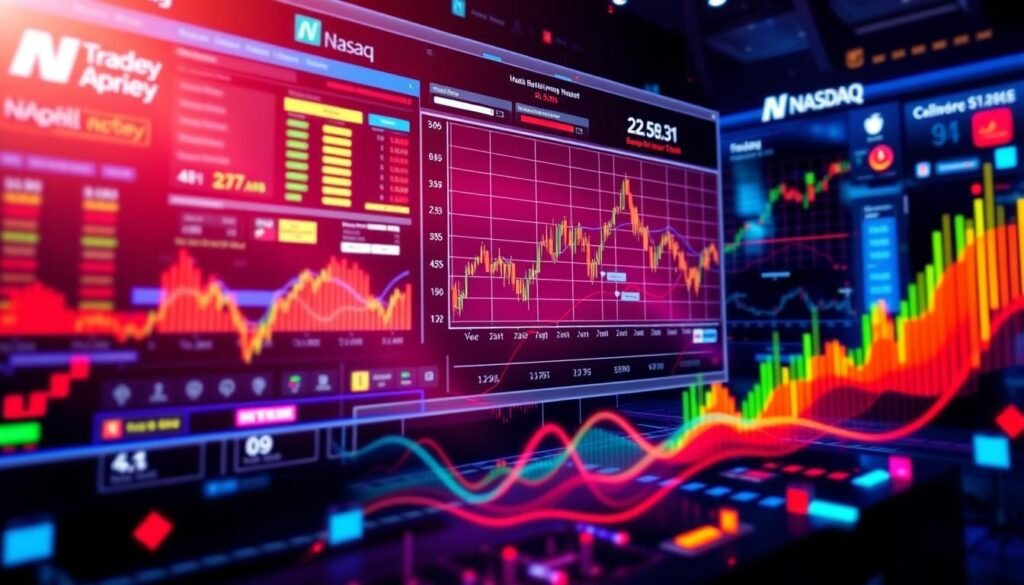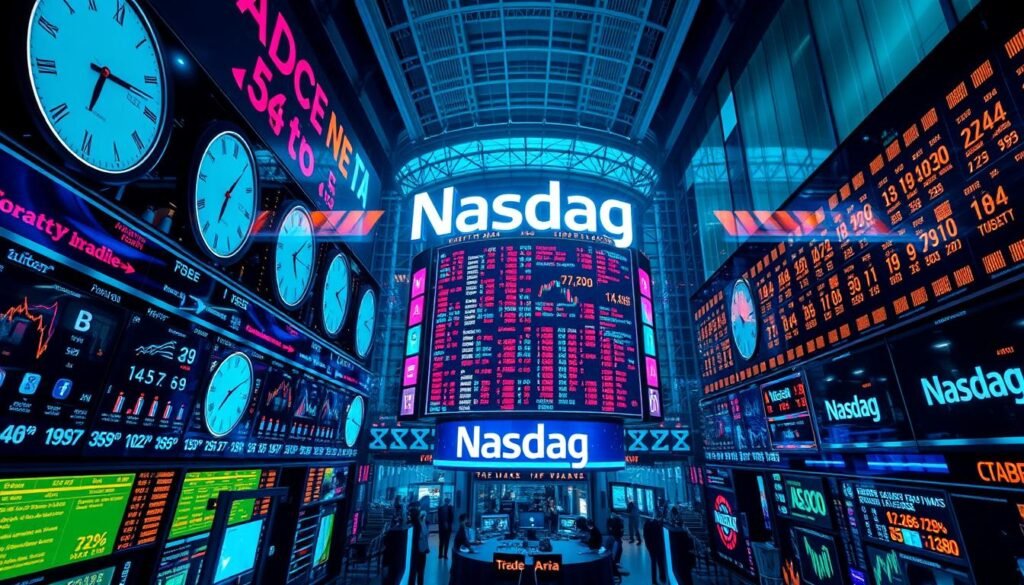The Nasdaq stock market is a top electronic marketplace. It has its own trading hours that investors need to know. Trading happens from early morning to late evening, giving traders many chances to buy and sell.
Nasdaq trades from 9:30 a.m. to 4:00 p.m. ET, Monday to Friday. But, the market is active even outside these hours. Pre-market trading is from 4:00 a.m. to 9:30 a.m. ET. After-hours trading is from 4:00 p.m. to 8:00 p.m. ET.
Key Takeaways
- Nasdaq stock market operates from 4:00 a.m. to 8:00 p.m. ET, with regular trading hours from 9:30 a.m. to 4:00 p.m. ET.
- Pre-market trading occurs from 4:00 a.m. to 9:30 a.m. ET, and after-hours trading takes place from 4:00 p.m. to 8:00 p.m. ET.
- Understanding Nasdaq’s trading hours is crucial for traders to optimize their strategies and manage risk effectively.
- The stock market is closed on weekends and observes specific federal holidays.
- Traders should be aware of the increased volatility and liquidity changes during pre-market and after-hours trading sessions.
Understanding Nasdaq Stock Market Hours
Stock trading is complex, and knowing the market timings is key. For the Nasdaq Stock Market, traders must understand the regular hours and the different sessions in a day.
Regular Trading Session Hours
The Nasdaq Stock Market is open from 9:30 a.m. to 4:00 p.m. Eastern Time (ET), Monday to Friday. This is the main time for investors to trade securities listed on the exchange.
Market Sessions Overview
- Pre-market trading: Starts at 4:00 a.m. ET and ends at 9:30 a.m. ET.
- Regular trading: Runs from 9:30 a.m. ET to 4:00 p.m. ET.
- After-hours trading: Goes from 4:00 p.m. ET to 8:00 p.m. ET.
Time Zone Considerations
All Nasdaq trading hours are in Eastern Time (ET). This can be Eastern Standard Time (EST) or Eastern Daylight Time (EDT) depending on the season. Traders in other time zones must adjust their schedules to match the trading session timings and regular trading hours.
| Exchange | Regular Trading Hours (ET) | Pre-Market | After-Hours |
|---|---|---|---|
| Nasdaq | 9:30 a.m. – 4:00 p.m. | 4:00 a.m. – 9:30 a.m. | 4:00 p.m. – 8:00 p.m. |
| NYSE | 9:30 a.m. – 4:00 p.m. | 4:00 a.m. – 9:30 a.m. | 4:00 p.m. – 8:00 p.m. |
“Understanding the Nasdaq stock market hours is crucial for traders to effectively manage their trading strategies and capitalize on market opportunities.”
Pre-Market Trading on Nasdaq
Nasdaq’s pre-market trading hours start at 4 a.m. Eastern time. This lets investors trade before the usual 9:30 a.m. to 4 p.m. hours. It’s a chance to act on overnight news before the market opens.
But, trading volume is often lower. This leads to more volatility and wider spreads between bid and ask prices.
Before, only big investors could trade before the market opened. Now, anyone can through online brokers and platforms. Yet, some places like Charles Schwab have rules. They limit certain trades during these early hours.
Individual investors might find it harder than big investors. This is because of differences in buying power and pricing. Also, fewer market makers and specialists in after-hours can make it harder to find liquidity.
Before trading early, think about the risks and benefits. Consider things like fees, how easy it is to trade, and price uncertainty. Knowing the challenges of pre-market and after-hours trading on Nasdaq is key for traders.
“Pre-market trading can lead to increased volatility due to lower liquidity and fewer market participants during those hours.”
Regular Trading Hours and Core Sessions
The Nasdaq stock market has regular hours from 9:30 a.m. to 4:00 p.m. Eastern Time (ET) on weekdays. It’s split into two main periods: morning and afternoon trading.
Morning Trading Period
The morning session starts at 9:30 a.m. ET. It’s often more volatile as the market reacts to overnight news. Traders look to capitalize on these early movements.
Afternoon Trading Period
The afternoon session runs from 12:00 p.m. to 4:00 p.m. ET. It sees more activity as investors and traders prepare for the close. This is when they finalize their positions and adjust strategies.
Market Close Procedures
Market close procedures start at 3:50 p.m. ET. The official closing price is set at 4:00 p.m. ET through a closing cross auction. This ensures a fair and transparent price for the day’s trading.
| Session | Trading Hours (ET) | Key Characteristics |
|---|---|---|
| Morning Trading Period | 9:30 a.m. – 12:00 p.m. | Higher volatility, market reactions to overnight news |
| Afternoon Trading Period | 12:00 p.m. – 4:00 p.m. | Increased trading activity, position adjustments before close |
| Market Close | 3:50 p.m. – 4:00 p.m. | Closing cross auction, determination of official closing price |
Knowing the Nasdaq’s core trading hours helps traders. It aids in understanding the morning and afternoon sessions. This knowledge is key for making smart decisions during market open and close times.
After-Hours Trading Sessions
Investors looking to act on news or earnings reports after hours can use the Nasdaq’s extended sessions. These sessions run from 4:00 p.m. to 8:00 p.m. Eastern Time (ET). They allow for buying and selling stocks after the market closes.
But, after-hours trading comes with its own set of challenges. Liquidity is often lower, leading to wider spreads and more volatility. This makes it harder to trade at the price you want, increasing risk.
Before trading in extended trading hours or after-market sessions, having a solid strategy is key. Only limit orders are available, and not all stocks can be traded during these times.
“Traders in the after-hours market must compete against large institutional investors who have more resources and sophisticated trading algorithms at their disposal.”
Extended trading hours can offer chances to make money from news or market shifts. But, the lower liquidity and higher volatility can also increase the risk of losses. Investors should think carefully about the risks and benefits before trading after hours.
The Nasdaq isn’t the only place for after-hours trading. The NYSE Arca Equities also has a late session from 4 p.m. to 8 p.m. ET. Other brokerages may offer extended hours too. Traders should know the rules and limits of their chosen platform.
Extended Hours Trading Options
Extended hours trading is now a big deal for investors. It gives them more flexibility and access to markets. This is thanks to Electronic Communication Networks (ECNs) that match buyers and sellers outside regular hours. Online brokers like Fidelity, Charles Schwab, and Interactive Brokers offer this to their clients.
Electronic Communication Networks (ECNs)
ECNs are key for extended hours trading. They let traders buy and sell securities directly, without a middleman. This means orders can be matched before, after, and even overnight, giving traders more chances to trade.
Available Trading Platforms
Platforms like Robinhood Markets now offer 24-hour trading for some stocks and ETFs. This lets traders work their trades and watch their positions anytime. It’s great for those who like to trade on their own schedule. But, it’s important to know what your broker offers and any extra costs or rules.
Extended hours trading is flexible, but it also has risks. There might be less trading, which can make prices wider and more volatile. Orders might also be harder to get through. Traders need to be careful and plan their strategies well.
The rise of ECNs and extended trading options has opened new doors for traders. Knowing the risks and how they work can help investors make smart choices. This way, they can take advantage of market changes outside regular hours.
Nasdaq Stock Market Hours vs NYSE Hours
Trading on financial markets depends on the hours of the Nasdaq and New York Stock Exchange (NYSE). Both exchanges trade from 9:30 a.m. to 4:00 p.m. Eastern Time (ET). Yet, they differ in their extended trading hours.
The Nasdaq starts its pre-market session at 4:00 a.m. ET. This is an hour before the NYSE’s early trading session at 7:00 a.m. ET. Nasdaq traders get three extra hours to trade before the regular session starts.
Both exchanges end their after-hours trading at 8:00 p.m. ET. This creates a consistent extended trading window for investors.
| Market Hours | Nasdaq | NYSE |
|---|---|---|
| Pre-Market | 4:00 a.m. – 9:30 a.m. ET | 7:00 a.m. – 9:30 a.m. ET |
| Regular Trading | 9:30 a.m. – 4:00 p.m. ET | 9:30 a.m. – 4:00 p.m. ET |
| After-Hours | 4:00 p.m. – 8:00 p.m. ET | 4:00 p.m. – 8:00 p.m. ET |
Traders need to consider these differences when planning their strategies. The extended hours offer more chances or risks, based on their goals and risk tolerance.
In summary, the Nasdaq and NYSE have the same core trading hours. But the Nasdaq’s pre-market session starts earlier. This gives traders three extra hours to trade before the regular session. Both exchanges have the same after-hours trading window, offering extended market access to investors.
Holiday Schedule and Market Closures
Investors and traders need to know the Nasdaq stock market’s holiday schedule. This helps them plan their trading activities. The Nasdaq exchange closes on federal holidays and some early closure days at 1:00 p.m. ET.
Federal Holidays
Nasdaq observes nine federal holidays each year. These include:
- New Year’s Day
- Martin Luther King Jr. Day
- Presidents’ Day
- Good Friday
- Memorial Day
- Juneteenth
- Independence Day
- Labor Day
- Thanksgiving Day
- Christmas Day
Early Closure Days
The Nasdaq also closes early on some days. This includes the day after Thanksgiving and Christmas Eve, closing at 1:00 p.m. ET.
Traders should check the official Nasdaq trading calendar. This ensures they know about all market closures and hours. Such changes can affect liquidity and volatility.
| Event | Closure Date | Market Close Time |
|---|---|---|
| Thanksgiving Day | November 28, 2024 | Closed |
| Day after Thanksgiving | November 29, 2024 | 1:00 PM ET |
| Christmas Eve | December 24, 2024 | 1:00 PM ET |
| Christmas Day | December 25, 2024 | Closed |
Knowing the Nasdaq stock market holidays and early closures helps traders. It lets them plan better and be ready for changes in market liquidity and volatility.
24-Hour Trading Developments
The financial markets are changing to be more open and flexible. In the U.S. stock market, round-the-clock trading is becoming more popular. Brokers like Interactive Brokers now let investors trade from 8:00 p.m. to 3:50 a.m. ET.
Robinhood Markets has gone even further. It offers continuous market access for some stocks and ETFs, 24/7. This means Robinhood users can place orders and watch prices even when the regular exchanges are closed. Robinhood uses Blue Ocean Alternative Trading Systems (BOATS) for these late-night trades, with safety measures to avoid big price swings.
This trend isn’t just for individual brokers. The New York Stock Exchange plans to open 22 hours a day on its Arca platform, pending approval. This move aims to give global investors more chances to trade in the U.S. equities market at any time.
“The markets never sleep, and neither should your investments. These developments in 24-hour trading are empowering investors to seize opportunities and manage their portfolios with greater agility.”
As the financial world keeps changing, round-the-clock trading and continuous market access will become key for investors. They will help investors stay on top of the market and make the most of every opportunity, no matter the time.
International Trading Considerations
In the global financial world, knowing how Nasdaq’s hours match up with local times is key for international traders. Big exchanges like the London Stock Exchange, Tokyo Stock Exchange, and Hong Kong Stock Exchange have their own hours. These hours might match or add to Nasdaq’s. Smart traders can tap into global markets through American Depositary Receipts (ADRs) during U.S. trading times.
Global Market Synchronization
Trading across borders means knowing about time differences, holidays, and news from around the world. Traders need to keep up with the trading times and sessions of their target markets. This helps them manage their portfolios well and grab chances in different time zones.
Cross-Border Trading Times
- The U.S. stock market, including the Nasdaq, runs from 9:30 a.m. to 4:00 p.m. EST. There’s pre-market trading from 4:00 a.m. to 9:30 a.m. EST and after-hours from 4:00 p.m. to 8:00 p.m. EST.
- U.S. exchanges trade overnight from 8:00 p.m. to 4:00 a.m. EST, Sunday through Thursday.
- Global exchanges like the London Stock Exchange, Tokyo Stock Exchange, and Hong Kong Stock Exchange have their own hours. These hours often match or overlap with Nasdaq’s.
- Traders can invest in international markets through ADRs during U.S. trading hours. This makes cross-border investing smooth.
By grasping global trading hours and aligning their plans, international traders can use global trading hours and international market access to their benefit. They can optimize their investment portfolios and seize chances in various time zones.
Trading Volume Patterns During Different Sessions
The Nasdaq stock market sees big changes in trading volume at different times. Knowing these patterns is key for traders wanting to do well. It helps them use the market’s liquidity to their advantage.
From 9:30 a.m. to 4:00 p.m. Eastern Time (ET), the Nasdaq is busiest. This is true at the start and end of the day. Traders and investors move quickly in response to overnight news.
But, the pre-market and after-hours times are different. From 4:00 a.m. to 9:30 a.m. ET and 4:00 p.m. to 8:00 p.m. ET, there’s less market liquidity. This means wider spreads and more price swings. It’s harder to trade efficiently during these times.
- The first and last hours of regular trading often see elevated trading volumes as traders respond to overnight news and position themselves for the day’s close.
- Pre-market and after-hours sessions typically experience lower trading volumes, which can result in wider spreads and more volatile price movements.
- Experienced traders may limit their positions during the volatile opening and closing hours, opting for limit orders to protect against unexpected price swings.
By knowing when trading volume changes, traders can make better choices. This can lead to better performance and less risk. It’s all about understanding when the market is most active.
“Traders should be aware of the timing for setting transactions when trading with cash to avoid account restrictions.”
Special Market Hours for Different Securities
The Nasdaq Stock Market is open from 9:30 am to 4:00 pm Eastern Time. But, some securities have their own hours. It’s important for traders to know the exact times for their investments.
ETFs Trading Hours
Exchange-Traded Funds (ETFs) usually trade during Nasdaq hours. Yet, some ETFs have longer trading times. This lets investors trade before or after regular hours. It’s key to check the trading schedule for the ETFs you’re interested in.
Options Trading Schedule
The Nasdaq Options Market runs from 9:30 a.m. to 4:15 p.m. ET. There’s also a pre-market session from 7:30 a.m. ET. Options traders need to know the exact hours for their options, as they can vary.
Knowing the special hours for ETF trading times and options market hours helps traders plan better. It ensures they can access the markets when needed. This knowledge is crucial for making smart investment decisions and grabbing opportunities in various financial instruments.
Market Hours During Exceptional Circumstances
The Nasdaq stock market usually opens during regular hours. But, it might change its schedule in special cases. These cases include severe weather, major technical issues, or big market swings.
For instance, Nasdaq closed for four days after the 9/11 attacks. It also closed for two days because of Hurricane Sandy in 2012. In such times, the exchange might stop trading to keep the market stable.
It’s important for traders and investors to know about any changes in Nasdaq’s hours. Having a plan for unexpected closures or disruptions is crucial.
“Unexpected events can significantly impact market operations, and traders must be prepared to respond accordingly. Maintaining a flexible and proactive approach is key to navigating such challenging circumstances.”
Knowing how Nasdaq handles special situations helps traders make better choices. It also helps them manage risks better, getting ready for any sudden changes.
Technology Systems and Trading Hours
The Nasdaq stock market runs smoothly thanks to its advanced technology. It operates from 4:00 a.m. to 8:00 p.m. Eastern Time (ET). This includes the pre-market, regular trading, and after-hours sessions.
Other platforms like Nasdaq BX and Nasdaq PSX also operate. They might have different hours. For example, the Nasdaq Futures Exchange (NFX) runs from 6:45 p.m. to 5:15 p.m. ET the next day. Knowing these hours is key for traders who use different electronic trading systems or data feeds.
| Exchange | Trading Hours (Local Time) | Total Value |
|---|---|---|
| London Stock Exchange (LSE) | 8:00 AM – 4:30 PM | $3.83 Trillion |
| New York Stock Exchange (NYSE) | 9:30 AM – 4:00 PM | $25.62 Trillion |
| NASDAQ | 9:30 AM – 4:00 PM | $19.51 Trillion |
| Japan Exchange Group (TSE) | 9:00 AM – 6:00 AM (Lunch Break: 3:30 AM – 5:00 AM) | $6.54 Trillion |
| Shanghai Stock Exchange (SSX) | 9:30 AM – 3:00 PM (Lunch Break: 11:30 AM – 1:00 PM) | $6.56 Trillion |
| Hong Kong Stock Exchange (HKEX) | 9:30 AM – 4:00 PM (Lunch Break: 12:00 PM – 1:00 PM) | $6.76 Trillion |
| Euronext Paris | 9:00 AM – 5:30 PM | $5.08 Trillion |
| Australian Securities Exchange (ASX) | 10:00 AM – 4:00 PM (Extended Hours: 12:00 AM – 6:00 AM) | N/A |
| New Zealand Stock Exchange (NZX) | 10:00 AM – 4:45 PM | N/A |
The table shows the trading hours and total market value of major stock exchanges worldwide. It gives a broad view of the global market infrastructure. Knowing the hours of these electronic trading systems helps traders navigate international markets better.
“Navigating the global financial markets requires a deep understanding of the operational hours and technological systems that power these exchanges. By staying informed, traders can make more informed decisions and capitalize on opportunities across multiple time zones.”
Risk Management During Extended Hours
Trading in extended hours comes with big challenges. Investors face lower liquidity, wider spreads, and more volatility. This can lead to sudden price changes. News and earnings reports outside regular hours can cause big price swings, affecting trading plans.
To handle these risks, traders should use certain strategies:
- Use limit orders to set entry and exit prices, reducing the effect of sudden price changes.
- Watch out for gaps between closing and opening prices, which can cause unexpected market shifts.
- Keep an eye on how reduced trading volume affects your strategies, as less liquidity can make volatility worse.
Good risk management is key in extended hours trading. By using these methods, traders can deal with the challenges of trading risks and volatility management. This helps them succeed in the fast-paced extended hours market.
“Extended hours trading can present both opportunities and risks. Careful planning and disciplined execution are essential to managing the heightened volatility and lower liquidity that can occur during these sessions.”
As more people trade in extended hours, it’s vital to know the unique risks. Investors need to develop strategies to manage these risks. By focusing on trading risks and volatility management, traders can confidently navigate the extended hours market. They can also take advantage of the opportunities it offers.
Conclusion
Knowing the Nasdaq stock market hours is key for good trading strategies. The main trading time is from 9:30 a.m. to 4:00 p.m. ET. But, there are also extra hours for trading.
It’s important to understand premarket, after-hours, and international trading. You need to watch for things like liquidity and volatility. Knowing these details helps you trade better in the Nasdaq market.
Whether you’re new or experienced, knowing the Nasdaq hours is vital. It helps you make smart trading plans. By keeping up with market trends, you can take advantage of the Nasdaq’s opportunities.
FAQ
What are the regular trading hours for the Nasdaq stock market?
The Nasdaq stock market trades from 9:30 a.m. to 4:00 p.m. ET, every weekday.
What are the different trading sessions on the Nasdaq?
The Nasdaq has three main sessions. These are pre-market (4:00 a.m. to 9:30 a.m. ET), regular market (9:30 a.m. to 4:00 p.m. ET), and after-hours (4:00 p.m. to 8:00 p.m. ET).
How do time zone differences impact Nasdaq trading hours?
Nasdaq trading hours are always in Eastern Time (ET). This can be EST or EDT, depending on the season. Traders in other time zones need to adjust their schedules.
What are the key characteristics of pre-market trading on Nasdaq?
Pre-market trading happens from 4:00 a.m. to 9:30 a.m. ET. It allows traders to react to overnight news. However, it has lower volume, higher volatility, and wider spreads.
What are the differences between the morning and afternoon trading periods on Nasdaq?
The morning session (9:30 a.m. to 12:00 p.m. ET) is often more volatile due to overnight news. The afternoon session (12:00 p.m. to 4:00 p.m. ET) sees more activity as traders prepare for the market close.
How does after-hours trading on Nasdaq differ from regular trading hours?
After-hours trading runs from 4:00 p.m. to 8:00 p.m. ET. It has lower liquidity and higher volatility. Traders react to late news or earnings reports.
What are the Extended Hours trading options available on Nasdaq?
Extended hours trading is available through ECNs. Many online brokers, like Fidelity and Charles Schwab, offer this to individual investors.
How do the Nasdaq and NYSE trading hours compare?
Nasdaq and the NYSE have the same regular hours of 9:30 a.m. to 4:00 p.m. ET. But, their extended hours differ. Nasdaq’s pre-market starts at 4:00 a.m., while NYSE’s early trading starts at 7:00 a.m. ET.
What are the Nasdaq market holidays and early closure days?
Nasdaq has nine federal holidays and early closure days. These include the day after Thanksgiving and Christmas Eve, closing at 1:00 p.m. ET.
How is 24-hour trading being implemented in the U.S. stock market?
Brokers like Interactive Brokers offer overnight trading. Robinhood Markets provides 24/5 trading for some stocks and ETFs. The NYSE plans to have 22-hour trading on its Arca platform.
What factors should international traders consider when trading on Nasdaq?
International traders need to know about Nasdaq hours and local time zones. They should also be aware of other global exchanges’ trading hours. This includes market holidays and news impacts from different regions.
How does trading volume vary across different Nasdaq sessions?
Regular hours have the most volume and liquidity. Pre-market and after-hours have less volume. This can lead to wider spreads and more volatile prices.
Are there any differences in trading hours for specific securities on Nasdaq?
Most stocks trade during standard Nasdaq hours. But, some securities have different schedules. For example, ETFs trade during regular hours but may also be available in extended sessions. Options trading on the Nasdaq Options Market operates from 9:30 a.m. to 4:15 p.m. ET.
How does Nasdaq respond to exceptional circumstances that may affect trading hours?
Nasdaq may change its hours for severe weather, technical issues, or market volatility. Circuit breakers and trading halts can be used to manage extreme market movements.
What technical infrastructure supports Nasdaq’s trading hours?
The main Nasdaq system operates from 4:00 a.m. to 8:00 p.m. ET. Other platforms, like Nasdaq BX and Nasdaq PSX, may have different hours. The Nasdaq Futures Exchange (NFX) has extended hours from 6:45 p.m. to 5:15 p.m. ET the next day.
What are the key risks associated with extended hours trading on Nasdaq?
Extended hours trading has risks like lower liquidity, wider spreads, and higher volatility. This can cause unexpected price movements. Traders should use limit orders and be aware of potential gaps between closing and opening prices.









